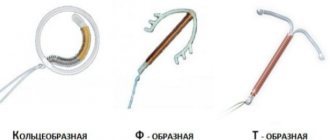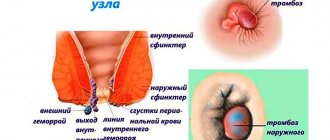Surgery to remove hemorrhoids is a radical way to treat a disease that is in an advanced form or has complications. The choice of technique depends on the type of pathology, therefore, before the start of surgery, diagnostics are carried out to assess the patient’s condition and identify the characteristics of the inflammatory process. The stages of the disease and concomitant diseases must be taken into account.
Surgery to remove hemorrhoids is a radical way to treat a disease that is in an advanced form or has complications.
Indications for surgery
Indications for surgery to remove hemorrhoids are the following factors:
- Detection of chronic paraproctitis.
- Lack of effectiveness from the use of conservative methods of treating hemorrhoids.
- The presence of severe bleeding caused by the inflammatory process.
- A chronic form of pathology, accompanied by other diseases of the rectum and complications.
- Progression of the disease over several months, as a result of which the patient’s condition worsens, and the symptoms are not eliminated with the help of medications and other means.
https://youtu.be/5okv6iPsBAU
Preparatory procedures
Before surgery to remove hemorrhoids, additional preparatory measures should be taken:
- visual inspection;
- instrumental diagnostics;
- laboratory tests;
- purgation.
To determine the treatment option, the surgeon examines the patient, identifies disturbing symptoms, and identifies the nature of the course and severity of hemorrhoids. After visual contact, the patient is prescribed a medical examination, including tests and instrumental diagnostics.
Preparation for a dangerous removal operation involves the collection of biological materials to determine coagulability, platelet and red blood cell levels, establish the Rh factor, and identify infectious, colds, and viral diseases. Mandatory methods of instrumental diagnostics are anoscopy and sigmoidoscopy. These methods make it possible to determine the size, location of hemorrhoids, probable complications of the pathology to determine possible risk factors and contraindications to surgical intervention.
You need to prepare for the operation in advance. Before surgery to remove hemorrhoids, you should follow a diet to normalize the functioning of the intestinal tract in order to avoid constipation, diarrhea, and increased gas formation.
If swelling, swelling, or ulcerative tumors have formed in the anal area, they should be localized as much as possible with the help of medications.
Before the operation, you should cleanse the intestines with a microenema or rectal suppository, and also refrain from eating and drinking 12 hours before the procedure if general anesthesia is used, and also shave the anal area. Hemorrhoidectomy is an operation to remove hemorrhoids, which is used quite often in proctology.
Today, surgical treatment of hemorrhoids is the most common treatment among all pathologies of the digestive system and digestive tract.
Inflammation of hemorrhoidal cones, as well as thrombosis of the veins in the anus, are diagnosed very often.
Morgan-Milligan hemorrhoidectomy is an effective technique for treating hemorrhoids and removing lumps. According to this technique, the operation is carried out using an open type and a closed type.
This operation is not performed on all patients, and most often it is used already in the third or fourth stage of hemorrhoid development.
Selection criteria for Morgan-Milligan hemorrhoidectomy
Before deciding on surgical treatment of hemorrhoids using the Morgan-Milligan method, the doctor must assess the extent of the pathology and the risk of complications after surgery:
- The degree of development of hemorrhoids . Hemorrhoidectomy can be performed at any stage of the development and course of the pathology, but the most effective treatment is when the hemorrhoids are large and they extend quite far beyond the anus;
- The patient's age must be taken into account . The operation is performed on patients over 40 years of age. If the patient's age is young, then there is a possibility of relapse of the disease, and in order to avoid this, there is an age barrier for hemorrhoidectomy surgery;
- The presence in the body of somatic diseases that develop along with hemorrhoids . If these pathologies are in an acute stage of development, or in the stage of relapse, then the operation is postponed until the patient’s health has stabilized. After this, it will be possible to perform a hemorrhoidectomy;
- Hemorrhoidectomy is not performed for intestinal inflammation and Crohn's disease . With these pathologies, there is a high risk of exacerbation of inflammation during surgery;
- Hemorrhoidectomy is not performed while a woman is carrying a child , or if the patient has a malignant neoplasm of the rectum.
Also, hemorrhoidectomy is not performed on patients with weakened immune systems and with AIDS pathology.
[img] src=”https://moyakrov.info/wp-content/uploads/2018/01/gemorroidektomiya-po-Morganu-Milliganu.jpg” class=”aligncenter” width=”597″ height=”315″[ /img] Morgan-Milligan hemorrhoidectomy
When is a hemorrhoidectomy prescribed?
Surgical intervention on the rectum is performed only if there are such signs of pathology for hemorrhoids:
- After the defecation procedure, hemorrhoids fall out of the rectum;
- Constant bloody discharge and bleeding from the anus. This manifestation of hemorrhoids leads to anemia in the body, because the concentration of hemoglobin in the blood decreases, and the level of red blood cell molecules in the blood decreases;
- Hemorrhoid nodes are in the third degree of pathology in size, and the development of hemorrhoids already reaches the fourth stage of the disease;
- High risk of vein thrombosis in the rectum. This sign of hemorrhoids requires urgent surgical treatment;
- Other ways to get rid of the disease did not help - drug treatment and diet did not help reduce hemorrhoids.
Surgical treatment of the disease is prescribed to the patient when the disease progresses and the patient cannot work and live well.
[img] alt=”proctologist” src=”https://moyakrov.info/wp-content/uploads/2018/01/proktolog.jpg” class=”aligncenter” width=”700″ height=”461″[/ img] The proctologist chooses the method of operation in accordance with the signs of pathology, as well as depending on laboratory indicators of the patient’s condition.
Contraindications to hemorrhoidectomy
A proctologist tries, whenever possible, to treat hemorrhoids using conservative medical methods, because surgical removal of hemorrhoids always involves the risk of surgical intervention in the body.
This risk especially increases in older people, when in the body, in addition to hemorrhoids, other pathologies develop, such as:
- Elevated blood pressure index - hypertension;
- Disease of the endocrine organs—diabetes mellitus;
- Pathology enterocolitis;
- For varicose veins in an advanced stage;
- If there is a disturbance in the hemostatic system and poor blood clotting;
- For heart failure;
- After a myocardial infarction and stroke;
- In pathology, arrhythmia;
- For disturbances in the functioning of the heart valves.
Also contraindications to hemorrhoidectomy are:
- Cracks in the rectum;
- Fistulas on the anus;
- Polyps on the anus;
- Diseases of the large intestine in the acute phase of development, as well as chronic pathologies in the relapse stage;
- Neoplasms of a malignant oncological nature - rectal cancer;
- Pathologies of the blood flow system and cardiac organ during the period of acute exacerbation;
- Pathologies of the respiratory system in acute forms of development;
- Infectious diseases in the body;
- The period of intrauterine gestation, as well as the period of breastfeeding.
With these contraindications, hemorrhoidectomy is not completely ruled out; quite often you just have to wait out the time of exacerbation of concomitant pathologies, or the period of pregnancy.
[img] alt=”surgery” src=”https://moyakrov.info/wp-content/uploads/2018/01/2497617-0pr3.jpg” class=”aligncenter” width=”700″ height=”350″ [/img] Often the proctologist recommends simply preparing your body for surgical treatment and strengthening your body as much as possible and treating diseases that are a contraindication for hemorrhoid surgery.
How to properly prepare for hemorrhoidectomy?
Hemorrhoidectomy is not an open operation in the abdominal cavity, but it is a surgical procedure that disrupts the integrity of the cells of the crust, as well as muscle fibers and mucosa.
The preparatory stage of hemorrhoidectomy is also provided, and how correctly the patient goes through it, the operation will be successful. Proper preparation is more than 50% of a successful result.
In order to schedule the planned removal of a hemorrhagic node, a diagnostic examination of hemorrhoids is performed.
In such cases, the palpation technique is not enough, and this method does not provide all the information for performing an operation to excise hemorrhoids.
Instrumental research methods are prescribed:
- Technique anoscopy of the rectum;
- The research method is sigmoidoscopy.
In order for radical therapy to be carried out, it is also necessary to donate blood for laboratory testing:
- General analysis of blood composition;
- Biochemical study, which should indicate the following indicators: blood bilirubin and glucose index, ALT and AST indicators;
- Lipid blood test;
- Analysis by coagulogram method;
- Markers for detecting hepatitis in the body;
- Analysis for syphilis and HIV, AIDS;
- Identification of blood group and rhesus composition;
- Analysis of the functionality of the hemostasis system and the blood plasma coagulability index and the duration of this process.
[img] src=”https://moyakrov.info/wp-content/uploads/2018/01/fortrans.jpg” class=”aligncenter” width=”700″ height=”350″[/img] Before the appointed day surgery, it is necessary to perform a cleansing enema, or if it is not possible to give an enema, then you need to take the drug Fortrans.
A few days before the scheduled time of hemorrhoidectomy, do not take drugs that thin the blood plasma (anticoagulants and antiplatelet agents).
It is also necessary to remove hair from the perineum and anus the day before.
During the preparation period, the psychological attitude is also very important; there is no need to listen to the unpleasant experiences of people who have undergone surgery to remove internal and external hemorrhoids.
It is necessary to trust the professionalism of the proctologist-surgeon.
When using the Morgan-Milligan hemorrhoidectomy method, hospitalization of the patient is necessary, because this method of treatment requires general anesthesia.
When hemorrhoids are operated on using minimally invasive methods, patients have the lumps removed under local anesthesia, and do not leave the clinic after a few hours, and the rehabilitation period is spent at home.
Types of surgical treatment of hemorrhoids
To remove varicose veins in the anal area, the following effective types of operations are used:
- Classic type surgical treatment using the Morgan-Milligan method (hemorrhoidectomy);
- The form of closed surgery is based on the Ferguson method;
- Hemorrhoidectomy using the Longo method.
There are closed minimally invasive methods of hemorrhoidectomy, but the Morgan-Milligan method is the most popular among patients and proctologists, although this technique of cutting out external and internal hemorrhoids is quite traumatic and often has negative consequences.
This operation is performed only under general anesthesia, which is why significant preoperative preparation is required.
Feryuson's closed-type hemorrhoidectomy technique is a high-tech operation in which dilated veins of the rectum are excised and is aimed at suturing the mucosal tissue after internal hemorrhoids have been removed.
The postoperative rehabilitation period passes quite quickly.
Complications after this type of operation, when a hemorrhoidal node is removed in a closed type, complications are rare and they manifest themselves as follows:
- Possibility of bleeding;
- Surgical sutures may come apart;
- Swelling of the rectum and anus;
- Prolapse of part of the intestine beyond the anus.
The Longo hemorrhoidectomy technique is the most gentle way to cut out hemorrhoidal cones. This operation involves resection of a small area of the rectal mucosa.
With this method, hemorrhoids are not cut out, but simply pulled to a certain distance from the anus.
[img] src=”https://moyakrov.info/wp-content/uploads/2018/01/gemorroidektomiiya-metodom-Longo.jpg” class=”aligncenter” width=”640″ height=”227″[/img ]
With this technique, no stitches are applied, but only specialized staples are used. This type of treatment is performed under local anesthesia.
The disadvantage of Longo's technique is that it is impossible to treat external hemorrhoids.
Morgan-Milligan hemorrhoidectomy technique
The classic type of hemorrhoidectomy using the Morgan-Milligan method is constantly being improved and practically nothing remains from its first development except the name.
The advantage of this technique is that not only external hemorrhoids are treated, but also internal hemorrhoids are treated.
In case of the disease, the internal type of hemorrhoids is at the third or fourth stage, when the following symptoms are expressed:
- Severe hemorrhoidal bleeding;
- Danger of developing thrombosis;
- The cones are so large that it is very difficult to defecate.
In such a situation, only this hemorrhoidectomy technique can save you, in which the lump is cut off along with the mucous membrane.
Based on the methodology, which is a full-fledged operation, it is performed only under general anesthesia, and the patient remains under the supervision of medical personnel for 7-10 days.
Operation technology:
- The patient is positioned on the operating couch; special supports are provided for the legs;
- The anus is treated with antiseptic drugs;
- The operation is performed using an anoscope instrument;
- An anoscope is inserted into the anus, which finds the node and transmits information to the doctor;
- Using a vacuum or mechanical ligator, the node is sucked in and taken out (outside the anus);
- Next comes the suturing of the artery and clamping of the hemorrhoidal pedicle;
- Using the device, an electrocoagulator stops bleeding;
- The lump is removed;
- The wound remains open and a drain is placed in it.
[img] src=”https://moyakrov.info/wp-content/uploads/2018/01/gemorroidektomiya-po-Morganu-Milliganu-2.jpg” class=”aligncenter” width=”640″ height=”651 ″[/img] Hemorrhoidectomy according to Morgan-Milligan
Laser technique for hemorrhoidectomy
This technique refers to minimally invasive surgical technology.
Laser treatment of hemorrhoids is performed under local anesthesia. Laser treatment is effective, fast, and there is no need to be treated in a hospital for the week following surgery.
Operation technology:
- The anal sphincter is dilated;
- An anoscope is inserted into the anus to obtain more detailed information about the location of pathological foci;
- Laser burning of the hemorrhoid is performed. Burning is carried out layer by layer.
The patient goes home the same day and carries out at home the recommended measures for the rehabilitation of this surgical intervention.
Methods for treating hemorrhoids without using a scalpel
Minimally invasive hemorrhoidectomy techniques for the treatment of external type of hemorrhoids, as well as internal type:
| method name | characteristics of the technique |
| · quick method that takes no more than 3 hours; | |
| method of laser correction of hemorrhoids | |
| painless procedure, local anesthesia; | |
| Quite effective treatment. | |
| radio wave method of hemorrhoidectomy | · use of the Sugitron tool (radio wave knife); |
| · the use of this type of operation eliminates tissue scarring, as well as bleeding. | |
| disarterization technique | · method of innovative technologies; |
| · blocks blood flow to the vessels in the rectum; | |
| · hemorrhoidal cones are not filled with biological fluid; | |
| · the venous nodes dry out and are replaced by connective tissue cells. | |
| method of treating hemorrhoids - lagering using latex rings | · rings are placed on a large cone; |
| · the leg of the node is compressed within a few days; | |
| · the lump disappears; | |
| · the place where it was pulled dries out. | |
| sclerotherapy method | · this method allows you to treat venous expansion anywhere; |
| · an adhesive solution is injected into the lesion site; | |
| · sclerosis of the affected part of the vein occurs. | |
| thrombectomy method (evacuation of injured nodes) | · this method is the best treatment for external hemorrhoids at different stages of its progression; |
| · For thrombectomy, a laser or radio knife is used. | |
| electrocoagulation method | · During electrocoagulation, an electric knife is used. |
| method of treatment - cryodestruction | · use of low temperatures up to 196 degrees with a minus temperature mark. |
| photocoagulation method | · treatment of hemorrhoids using infrared radiation. |
Recovery period after hemorrhoidectomy
The recovery period after hemorrhoidectomy according to the Morgan-Milligan method, in most cases, is stable and successful.
The only inconvenience is the process of defecation, during which it is impossible to avoid pain.
The first day after hemorrhoidectomy, it is contraindicated to eat any food, but you need to drink plenty of fluids that do not irritate the intestinal mucosa.
Second rehabilitation day - you are allowed to eat liquid food:
- Soups with vegetable broth;
- Dairy products;
- Liquid or slimy porridges.
To speed up the process of regeneration of tissue cells in the operated area, they are treated with ointments that contain the active substance - methyluracil.
The rehabilitation process after hemorrhoidectomy according to Morgan-Milligan takes up to 10 days, when the patient is under observation in the hospital.
After discharge from the hospital, the patient receives recommendations from the attending doctor in order to consolidate the therapeutic effect after the operation:
- Do not carry heavy objects;
- Do not strain your abdominals;
- Maintain proper nutrition;
- Lead a correct and active lifestyle;
- Engage in physical therapy;
- Do not drink alcoholic beverages;
- Stop smoking.
[img] alt=”Soups with vegetable broth” src=”https://moyakrov.info/wp-content/uploads/2018/01/Supy-na-ovoshhnom-bulone.jpg” class=”aligncenter” width=” 600″ height=”406″[/img] It is recommended to eat soups with vegetable broth
Complications after hemorrhoidectomy surgery
Complications occur after any surgical intervention into the body, and they can also appear after surgery using the hemorrhoidectomy technique.
To avoid many postoperative complications, it is necessary to properly prepare for the operation.
Postoperative complications may include:
- Bleeding from the anus . To stop this type of bleeding, drugs are used that increase the clotting of blood plasma - the drug Tranexam, the hemostatic agent Dicynon;
- Constipation after hemorrhoidectomy is the most common complication after surgical treatment. This complication is most often at the psychological level - the patient is afraid to carry out the process of defecation due to pain;
- Most often, men experience problems with urination . Urine retention in the bladder is treated using catheterization techniques;
- Poor nutrition results in too dense stool . When exiting through the anus, they can form cracks on it, especially when operating on external hemorrhoids. To treat this complication, nitroglycerin ointment is used;
- The appearance of a fistula . It occurs because during hemorrhoidectomy, part of the muscle tissue cells was cut off, which resulted in the formation of a hole from the rectum to neighboring organs. Treatment for this complication is surgical correction;
- Complication in the form of narrowing of the anus and rectum . This pathology occurs because the connective cells of the tissues grow too much, which interferes with the normal exit of feces from the body. In order to correct this defect, correction is necessary to enlarge the rectum and anus;
- A complication may be the accumulation of blood under the mucosa , which forms a hematoma;
- If during surgery there is damage to the muscle tissue in the rectum , then complications may include incontinence of feces by the sphincter, as well as urine;
- If hygiene rules are not followed and antiseptic drugs are not used during the postoperative period , infection may enter the wound and suppuration will begin in it. The infection must be treated with antibacterial drugs.
[img] alt=”antibacterial drugs” src=”https://moyakrov.info/wp-content/uploads/2018/01/preparaty-antibakterialnogo-dejstviya.jpg” class=”aligncenter” width=”550″ height =»371″[/img] Antibacterial drugs
Swelling after hemorrhoidectomy
Perianal swelling is a postoperative complication that can be caused by many reasons.
Perhaps the swelling is the body’s reaction to a radical hemorrhoidectomy operation. Swelling can also occur due to the fusion of varicose veins in the period before surgery.
Swelling after the operation should go away no later than 3 weeks.
Cost of hemorrhoidectomy
The cost of surgical treatment of hemorrhoids depends on the location of the operation, as well as on the status of the medical institution where this treatment will be carried out.
You can remove hemorrhoids in a local clinic at your place of residence, then it may cost you completely free, but only the proctologist chooses the method of surgical treatment.
And such medical institutions do not have modern equipment and the latest technological methods.
To choose a less traumatic method of surgical treatment of hemorrhoids, it is better to go to a modern specialized clinic, but these minimally invasive techniques are not cheap.
[img] alt=”Prices depend on the region” src=”https://moyakrov.info/wp-content/uploads/2018/01/4576847674596748957694799.jpg” class=”aligncenter” width=”640″ height=”379 ″[/img]
Prices depend on the region of the clinic, in big cities it is more expensive, also on the status of the medical institution, on the status of the doctor and on the chosen technique.
Average prices for the removal of hemorrhoids in Russia:
- Sclerotherapy method for one node - approximately 3000.00 rubles;
- The method of treating hemorrhoids is ligation - 5000.00 rubles;
- Method of removing hemorrhoidal cones - desarterization - 20,000.00 rubles;
- Hemorrhoidectomy according to the Morgan-Milligan method - from 3000.00 rubles to 7000.00 rubles.
Pricing policies in private clinics may vary significantly.
Price table in large cities - in Moscow and St. Petersburg, as well as in the Moscow region:
| operation name | Moscow city prices in rubles | Moscow region prices in rubles | city of St. Petersburg cost in rubles |
| sclerotherapy | 750,00 — 15000,00 | 1600,00 — 13000,00 | 2700,00 — 11000,00 |
| hemorrhoidectomy according to the Morgan-Milligan method (1 hemorrhoid) | 1200,00 — 96000,00 | 200,00 — 32000,00 | 4000,00 — 53000,00 |
| reception lag | 950.00 – 44 thousand | 1.8 thousand - 32 thousand | 1.5 thousand - 38 thousand |
| electrocoagulation of one node | 1 thousand - 46 thousand | 2 thousand - 3.5 thousand | 2 thousand - 9 thousand |
| radio knife method, as well as laser | 650,00 — 35000,00 | 800,00 — 10000,00 | 1000,00 — 16000,00 |
| technique of disarterization of one node | 3500,00 — 100000,00 | 24000,00 — 67000,00 | 16000,00 — 49000,00 |
In addition to the operation itself, the preparatory process for it also costs a certain amount of money:
- Appointment with a proctologist - 500.00 rubles;
- Diagnostic examination - sigmoidoscopy - 1000.00 rubles;
- Laboratory diagnostics and preparation - up to 10,000.00 rubles.
Diet during the recovery process after surgery
For a quick recovery in the postoperative period, you must follow a strict diet and proper nutrition:
- You need to eat at least 5 times a day;
- A single serving of food should be no more than 200.0 grams - this will reduce the load on the intestines and correct the bowel movement process;
- Products should be easily digestible;
- Consume fermented milk products during snacking periods;
- Do not eat cabbage of all varieties, as well as legumes: peas, beans, beans, because they provoke the accumulation of gases in the intestines;
- Do not eat bread and flour products;
- Avoid hot spices in cooking;
- Do not eat marinades and canned foods - they irritate the intestinal mucosa;
- Drink a lot of liquid up to 2 liters - this will soften the stool;
- Don't drink carbonated drinks.
Video: Hemorrhoid removal operation, hemorrhoidectomy.
Conclusion
People who got rid of hemorrhoids using the hemorrhoidectomy method are divided into 2 categories, those who speak positively about this technique, and there are pessimists who express preoperative fear and cannot say anything about the operation itself.
This technique really allows people who have suffered from this disease for a long period of time to get rid of hemorrhoids and who have not been helped by conservative drug treatment.
Nowadays, hemorrhoidectomy, carried out using minimally invasive methods for getting rid of hemorrhoids, is gaining popularity, because it is a practically non-traumatic method, and also does not require long-term interruptions in the clinic.
A minimally invasive technique is suitable for people who cannot tolerate anesthesia for some reason - a minimally invasive operation is performed under local anesthesia.
The quality of getting rid of hemorrhoids using hemorrhoidectomy depends on how the patient behaves during the rehabilitation period and fulfills all the requirements of the recovery period and the recommendations of the treating doctor.
Related publications:
- [anchor href=»moyakrov.info/veny/gemorroj/chem-opasen»]Danger of hemorrhoids in men, women and pregnancy[/anchor]
- [anchor href=»moyakrov.info/preparaty/ot-gemorroya/maz-vishnevskogo»] How to use Vishnevsky ointment for external and internal hemorrhoids[/anchor]
- [anchor href=»moyakrov.info/veny/gemorroj/krovotochit-chto-delat»] Blood for hemorrhoids - what to do and how to treat? Review of drugs and folk remedies[/anchor]
- [anchor href=»moyakrov.info/veny/gemorroj/pochemu-pri-stule-idet-krov-iz-zadnego-prohoda-k-kakomu-vrachu-obratitsya»] Why does blood come from the anus during stool, which doctor to see contact?[/anchor]
Minimally invasive methods
These are the newest techniques that allow you to fight the disease in a “gentle” way. There are such varieties:
- sclerotherapy;
- IR coagulation;
- cryotherapy;
- ligation.
The selected methods of getting rid of the disease are carried out without general anesthesia. After completion of the intervention, the patient can immediately go home. Qualified doctors advise these techniques in the initial stages of the development of the disease. In more serious cases, surgical treatment of hemorrhoids is recommended.
Types of operations to remove hemorrhoids
Minimally invasive
The technique of using minimally invasive operations avoids complications and is characterized by a short rehabilitation period. These methods of removing hemorrhoids include:
- Node ligation. A coloproctologist prescribes this method to eliminate the external form of the disease. During the operation, a latex ring is used, which is placed on the inflamed node, as a result of which blood and nutrients do not flow to the site of inflammation. The hemorrhoidal lump dies, which leads to the patient’s recovery.
- Cryodestruction. The operation is performed using liquid nitrogen, which freezes the node. Another healing property of the procedure is its positive effect on the process of tissue restoration.
- Sclerosis. The operation is characterized by the introduction of a special substance into the node, which leads to the overgrowth of the vessels feeding the inflammatory focus.
- Radio wave removal of hemorrhoids. The operation is based on the action of electric current supplied to the inflamed area with the required degree of impact. As a result of infrared coagulation, hemorrhoids disappear, and thrombophlebitis and other consequences do not develop.
- Laser vaporization. The operation is a modern way to eliminate hemorrhoids. The technique is based on the use of laser radiation, which is used to influence the node. The advantage of this treatment method is that during the operation the excised tissue is immediately cauterized, so the risk of bleeding is minimal.
When ligating a node, a latex ring is used, which is placed on the inflamed node, as a result of which blood and nutrients do not flow to the site of inflammation.
Surgical removal
The classic method of surgical intervention is hemorrhoidectomy. The surgeon can use the following methods to remove nodes:
- Longo's technique. During the operation, internal hemorrhoids are removed. During the procedure, the intestinal mucosa that has undergone pathological changes is excised. The operation is characterized by a low risk of complications.
- Milligan-Morgan technique. The operation is aimed at excision of the inflamed node and intestinal mucosa. The event can be carried out in the later stages of hemorrhoids or in the presence of complications (tendency to bleeding or increased risk of vascular thrombosis).
- Ferguson's technique. Closed type of hemorrhoidectomy. The operation differs from the Milligan-Morgan method in that the wound is not left open after the intervention, but is sutured. This reduces recovery time and reduces the risk of negative consequences.
- Thrombectomy of a thrombosed hemorrhoid. The operation is performed in the presence of thrombosis. During the procedure, the blood clot is removed, which brings relief to the patient. It is necessary to pay attention to the fact that the technique is designed to eliminate unpleasant symptoms, but not the causes of the pathology, so the procedure will not help get rid of hemorrhoids.
Features of using a laser
Laser coagulation today is one of the most modern methods of treating hemorrhoids. For internal hemorrhoids, the essence of the effect is that the laser beam burns the hemorrhoids layer by layer. Small wounds that remain at the site of the nodes, due to the coagulating properties of the laser, do not bleed and heal quickly. In the external process, the enlarged node is cut with a laser. This causes cauterization of tissues and blood vessels, which prevents bleeding.
Indications and contraindications
Laser treatment is a highly effective treatment method if used as indicated.
The use of laser coagulation is recommended for:
- internal, external and combined hemorrhoids stages 1-2;
- the addition of inflammation of the rectal mucosa;
- development of anal fissure;
- bleeding internal hemorrhoids;
- node thrombosis.
If there are contraindications to hemorrhoidectomy in stages 3 or 4 of the disease, laser treatment is also used. Since it is not always possible to completely excise large hemorrhoidal vessels, in some cases a combination of laser and other methods of surgical correction is used.
A contraindication to the use of this technique is severe inflammation of the anal area. In this case, it is necessary to carry out conservative therapy (antibacterial, anti-inflammatory). After the inflammatory process has subsided, the use of laser treatment is possible.
Preparing for surgery
During the preoperative period, the man must be examined by a general practitioner, determining the presence of concomitant diseases of the internal organs. If necessary, a cardiologist and pulmonologist also consults. Blood and urine tests, electrocardiograms and other tests are carried out as prescribed by specialists. After establishing diagnoses and determining the general condition of the patient, an examination by an anesthesiologist is required. This doctor determines the risks of surgery and selects the type of anesthesia.
A week before the procedure, you need to start following a certain diet . You should:
- do not consume foods that cause bloating (carbonated drinks, fresh baked goods, legumes, corn, cabbage, kvass);
- refrain from indigestible foods that contribute to the development of constipation (canned food, fatty broths, rice, pasta, pears, dogwood);
- preference is given to plant foods (carrots, beets, zucchini) and fermented milk products (fresh kefir, fermented baked milk, a small amount of cottage cheese).
The day before, the patient undergoes a bowel cleanse, first taking laxatives (Fortrans), and then doing an enema.
Progress of the operation and postoperative period
Laser treatment is performed under local anesthesia. To do this, an anesthetic (benzocaine, lidocaine) is used, which is injected into the anal area. After a few minutes, when sensitivity disappears in this area, intervention begins.
For external hemorrhoids, the skin and underlying tissues are cut with a laser, and varicose veins are burned out layer by layer. In internal cases, using an optical device (anoscope), the location of the node is determined and layer-by-layer coagulation is carried out through slits in it. Large hemorrhoids are completely removed by excising their body and base, and for small ones, cauterization of their legs is effective. As a result, the remaining elements of the base are replaced by connective tissue.
After completion of the manipulation, the patient remains in a horizontal position for another half hour, and remains in the hospital until the effect of the painkillers wears off (about 3 hours). It is recommended to remove no more than 3 nodes in one procedure.
The rehabilitation period lasts about 10 days.
Basic recommendations:
- to eliminate pain during bowel movements in the first days, take painkillers (baralgin, analgin, paracetamol);
- to prevent straining and difficulty defecating, consume a sufficient amount of liquid (up to 1.5 liters per day), fermented milk products, fresh and processed (stewed) vegetables;
- carefully treat postoperative wounds with antiseptic agents, and wash with warm water after each bowel movement;
- refrain from physical activity and sexual activity.
After complete recovery, if necessary (a large number of changed nodes), repeated procedures are performed, on average, after 3 weeks.
Recovery
During the postoperative period, the patient should avoid physical activity.
Light exercise is allowed one week after the nodes are removed.
Light exercise is allowed a week after the nodes are removed, and sports can be done after 3 months.
Patients who have to sit for a long time should use a special pillow. It is not recommended to visit baths, saunas and other similar procedures.
After surgery to remove a hemorrhoid, you need to change your diet: exclude fatty and fried foods from the diet, eat boiled, stewed and baked foods. Food is taken 5-6 times a day.
Rehabilitation period after hemorrhoid removal
After the patient has had hemorrhoids removed, a rehabilitation period begins. Its timing is determined by the chosen method of surgical treatment and the patient’s well-being. Of great importance is adherence to a diet that promotes the formation of soft stool and regular bowel movements. On the first day, it is advisable to limit your water consumption to avoid the need for bowel movements. On the second day after surgery, you can already include low-fat broths and liquid fermented milk products (yogurt, kefir) in your diet. Boiled or stewed porridges and vegetables are allowed from the third day after surgery. Products that can cause increased gas formation and fermentation in the intestines, as well as irritate the mucous membrane and stimulate blood flow, should be completely excluded.
Proper nutrition after hemorrhoid removal promotes speedy recovery
If postoperative wounds remain as a result of the treatment, they are treated daily until complete healing with special agents prescribed by the doctor. After each urination or bowel movement, it is necessary to wash with antibacterial agents to prevent infection.
To reduce pain, local and systemic pain medications can be prescribed.
Advice: Compliance with all recommendations of the attending physician during the postoperative period reduces the risk of complications.
Postoperative complications
The following complications may occur after surgery:
- Fistulas.
- Narrowing of the rectal canal.
- Thrombosis of the hemorrhoid.
- Problems with urination.
- Rectal prolapse.
- The appearance and accumulation of pus.
After surgery, problems with urination may occur.
Preparing for surgery
All patients are prescribed the following examination:
- General blood test and biochemistry, coagulogram;
- general urine analysis;
- ECG;
- sigmoidoscopy;
- colonoscopy.
It is important before the operation to completely cleanse the intestines of contents, since feces can get on the wound surface and infect it, and in the first days, bowel movements can be very painful. To do this, an osmotic laxative (Fortrans) is prescribed a day before, and a cleansing enema is given in the evening and morning.
For 1 - 2 days, you need to eliminate legumes, hot seasonings, sauces, fried and fatty foods, smoked foods, baked goods, cabbage and alcohol from your diet. On the eve of the operation, a fasting diet is observed - dinner and breakfast are canceled.
Recovery period
The longest rehabilitation is required after open hemorrhoidectomy. Its duration is usually at least a month. The first week is very difficult for the patient: severe pain, difficulty urinating and emptying the intestines. During this period, painkillers and anti-inflammatory drugs are indicated.
Food is given in crushed form, laxatives and sufficient fluids are recommended. Due to the risk of complications and the difficult rehabilitation period, this type of surgery is almost never used.
The closed and submucosal method is recommended after 40-45 years, because hemorrhoids often recur at a young age. After surgery, physical activity is contraindicated for a month; you need to monitor bowel function and prevent constipation. The menu consists of liquid and pureed food.
Recommendations for patients after laser coagulation or other more gentle treatment methods:
- carefully carry out hygiene procedures in the perineal area;
- exclude spices, spicy foods, salt, and smoked foods from the diet;
- do therapeutic exercises or walking every day;
- be under constant supervision of a proctologist to monitor the results of the operation.
Radical methods
Radical operations are performed in a hospital setting, where the patient stays for a week. They last several hours and require general anesthesia or epidural anesthesia. The rehabilitation period lasts up to six months. These include: hemorrhoidectomy using the Milligan-Morgan method and hemorrhoidopexy using the Longo method.
Hemorrhoidectomy
During hemorrhoidectomy, excision and removal of hemorrhoids is performed mechanically. The founders of the method are surgeons Morgan and Milligan, who first proposed it in 1935.
In addition to the main contraindications, the operation is not performed on patients under 35 years of age, due to the risk of possible relapses. It is also not recommended for elderly people.
Surgery is performed using a scalpel knife, laser or electric coagulator.
Today, modern medicine allows us to distinguish three types of hemorrhoidectomy according to the Milligan-Morgan method, which have the same goal - getting rid of hemorrhoids, but in different ways.
- Open hemorrhoidectomy. The technique was directly proposed by Morgan and Milligan. During the intervention, not only hemorrhoids are removed, but also nearby tissue. The edges of the wound are not sutured, so regeneration and healing occurs naturally. The patient is monitored in a hospital, where he must stay for up to 10 days.
- Closed hemorrhoidectomy. This technique was proposed in the 50s of the twentieth century by doctors Heaton and Ferguson. Unlike the previous type, after the removal of hemorrhoids, the tissue is sutured. This procedure can be performed on an outpatient basis using local anesthesia. The rehabilitation period is shorter compared to open hemorrhoidectomy.
- Submucosal hemorrhoidectomy. The most complex method that requires high professionalism of a specialist. Its founder is surgeon Parks. During the operation, the immediate hemorrhoids are excised, while the bases of the formations remain, as a result of which injury to the mucous membrane does not occur.
Sequence of hemorrhoidectomy
The operation consists of the following steps:
- inserting an anoscope into the rectum in order to assess the general condition of hemorrhoids, facilitate access to them and decide on the sequence of their removal;
- capturing the nodes using a special clamp, removing them out and clamping the arteries feeding the pathological formations;
- stitching the legs of the hemorrhoid with catgut. Type of seam - figure eight shape;
- excision of hemorrhoidal node. For this purpose, a regular scalpel or electric knife is used, which prevents significant blood loss due to cauterization of blood vessels;
- The type of hemorrhoidectomy determines further work with the wound. The specialist can leave it open or sew it up;
- treatment of seams with antiseptics;
- insertion of a turunda soaked in medicinal ointment into the anus for 6 hours.
At the end of the operation, the anal area is covered with sterile material.
Next, the patient is sent to the ward under the supervision of a doctor.
The first few days after surgery, the patient experiences severe pain. To eliminate them, they resort to anesthetics.
Emptying the bowel during this period is undesirable due to severe pain, as well as the risk of injury and infection of the wound surface. Therefore, these days the patient is allowed to drink only liquids.
Only after 5 days the patient is allowed to eat. The diet should consist of liquid, non-rough, pureed food, which helps soften stool and not lead to flatulence and constipation. Meals should be fractional, that is, in small portions at short intervals. Drinking plenty of fluids is also recommended.
In some cases, hemorrhoidectomy leads to complications that may occur some time after the operation:
You can also read: Preparing for surgery to remove hemorrhoids
- urinary retention. Lasts about a day. More common in men. In this case, resort to the help of a catheter;
- acute pain syndrome, which is relieved with analgesics;
- rectal prolapse. It is rarely observed when the functioning of the anal sphincter is impaired and can be eliminated by medication or surgical methods;
- bleeding. Occurs due to injury to the wound by feces. If a large vessel is damaged, it requires suturing;
- the appearance of fistulas due to the development of infectious processes or inaccurate actions of the doctor during the operation;
- narrowing of the anus due to improper sutures. In this case, special dilators are used or anal plastic surgery is performed;
- infections if the doctor or patient does not comply with aseptic and antiseptic rules. If the use of antibiotics is ineffective and the wound becomes suppurated, it must be opened and washed;
- constipation, which can be relieved with diet and laxatives.
After hemorrhoidectomy, recurrence of hemorrhoids is quite rare.
Hemorrhoidopexy
This method of getting rid of hemorrhoids was proposed by the Italian professor Longo in 1993. Hemorrhoidopexy is performed:
- with internal hemorrhoids in the first two stages with large hemorrhoidal cones that cause serious inconvenience to the patient;
- internal hemorrhoids stage 3–4;
- circular prolapse of hemorrhoids;
- prolapse of hemorrhoids in combination with rectal prolapse;
- hemorrhoids, in which the rectum protrudes into the vagina.
The advantages of this technique are the high efficiency of the method, painlessness, absence of bleeding, speed, minimal risk of complications, the use of local anesthesia, the use of disposable instruments, and a short recovery period.
The disadvantages of this type of intervention include: the impossibility of applying it to the external form of hemorrhoids and the cost of the operation.
During the operation, hemorrhoidal formations are not removed, but are raised higher, and parts of the mucous membrane surrounding the hemorrhoid are excised. The edges of the resulting wound are connected using special titanium clips.
Raising of the nodules leads to disruption of blood circulation in them and, as a result, reduction in size, drying out and disappearance.
Instruments for hemorrhoidopexy
Hemorrhoidopexy restores the correct anatomical structure of the anal canal.
The operation goes through the following stages:
- expanding the surgical field by stretching the skin around the anus to the sides using surgical clamps;
- insertion of the expander and its subsequent fixation with sutures;
- entry through an anoscope expander;
- placing a muslin suture on the mucous membrane of the rectum above the location of the hemorrhoids;
- tightening the suture, removing the ends of the thread from the rectum;
- insertion of a circular stapler;
- performing a circular excision of hemorrhoids with a section of the rectal mucosa;
- connecting the edges of the wound with a special stapler using titanium staples;
- removing the anoscope and dilator;
- insertion into the anus of a tampon impregnated with a drug and a gas outlet, which are in the body during the day.
The operation lasts no more than half an hour and after a few days the patient is discharged from the hospital. The rehabilitation period lasts about a week.
In rare cases, the following complications are possible:
- intra-abdominal bleeding as a result of suture dehiscence;
- rectovaginal fistula with subsequent development of the inflammatory process;
- development of thrombosis.
Hemorrhoidectomy and hemorrhoidopexy are the main methods of getting rid of hemorrhoids. However, there are other types of surgical interventions that are performed in rare cases.
- Methodology according to Sklifosovsky. Termination of blood supply to hemorrhoids by tying their base with a strong thread, as a result of which they die;
- Method according to Martynov. Ligation of the base of the node with further cutting.
- Whitehead's technique. Removal of the affected area of the rectum with further suturing of healthy tissue to the anus. Recommended for severe complications.
How to properly prepare for hemorrhoidectomy?
Hemorrhoidectomy is not an open operation in the abdominal cavity, but it is a surgical procedure that disrupts the integrity of the cells of the crust, as well as muscle fibers and mucosa.
The preparatory stage of hemorrhoidectomy is also provided, and how correctly the patient goes through it, the operation will be successful. Proper preparation is more than 50% of a successful result.
In order to schedule the planned removal of a hemorrhagic node, a diagnostic examination of hemorrhoids is performed.
In such cases, the palpation technique is not enough, and this method does not provide all the information for performing an operation to excise hemorrhoids.
Instrumental research methods are prescribed:
- Technique anoscopy of the rectum;
- The research method is sigmoidoscopy.
In order for radical therapy to be carried out, it is also necessary to donate blood for laboratory testing:
- General analysis of blood composition;
- Biochemical study, which should indicate the following indicators: blood bilirubin and glucose index, ALT and AST indicators;
- Lipid blood test;
- Analysis by coagulogram method;
- Markers for detecting hepatitis in the body;
- Analysis for syphilis and HIV, AIDS;
- Identification of blood group and rhesus composition;
- Analysis of the functionality of the hemostasis system and the blood plasma coagulability index and the duration of this process.
Before the appointed day of the operation, it is necessary to perform a cleansing enema, or if it is not possible to give an enema, then you need to take the drug Fortrans.
A few days before the scheduled time of hemorrhoidectomy, do not take drugs that thin the blood plasma (anticoagulants and antiplatelet agents).
It is also necessary to remove hair from the perineum and anus the day before.
During the preparation period, the psychological attitude is also very important; there is no need to listen to the unpleasant experiences of people who have undergone surgery to remove internal and external hemorrhoids.
It is necessary to trust the professionalism of the proctologist-surgeon.
When using the Morgan-Milligan hemorrhoidectomy method, hospitalization of the patient is necessary, because this method of treatment requires general anesthesia.
When hemorrhoids are operated on using minimally invasive methods, patients have the lumps removed under local anesthesia, and do not leave the clinic after a few hours, and the rehabilitation period is spent at home.
Laser technique for hemorrhoidectomy
This technique refers to minimally invasive surgical technology.
Laser treatment of hemorrhoids is performed under local anesthesia. Laser treatment is effective, fast, and there is no need to be treated in a hospital for the week following surgery.
Operation technology:
- The anal sphincter is dilated;
- An anoscope is inserted into the anus to obtain more detailed information about the location of pathological foci;
- Laser burning of the hemorrhoid is performed. Burning is carried out layer by layer.
The patient goes home the same day and carries out at home the recommended measures for the rehabilitation of this surgical intervention.











